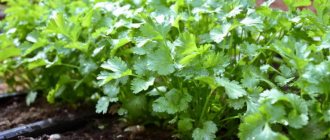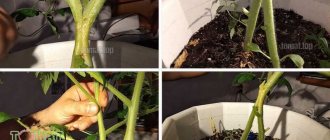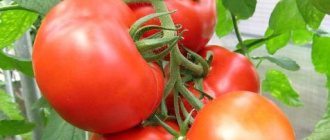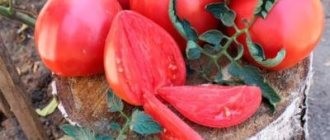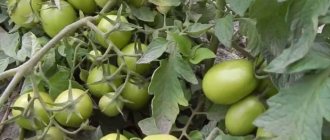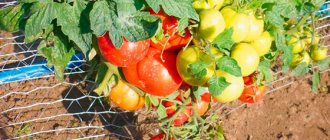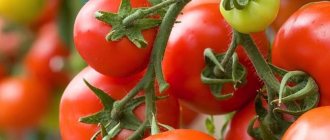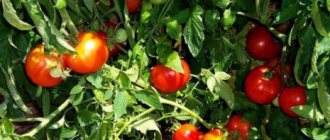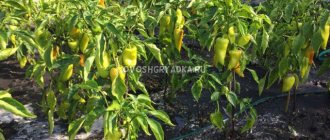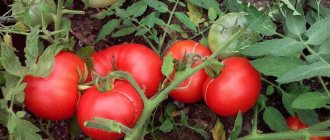Description of the Bonsai tomato variety
Bonsai tomatoes belong to the determinate type, with a possible growth height of no more than half a meter. The plant is independently capable of forming in the form of a trunk. The stems are strong, with a fleshy structure and do not need to be fixed to a support. The leaf component is abundant, but the leaves themselves are small in size, wrinkled and rich green in color. The initiation of inflorescences occurs above the 6th leaf - no further delimitation by leaves is observed.
The Bonsai tomato variety has compact bush dimensions, as it was obtained specifically for growing in separate flower pots as an ornamental plant. This does not exclude the possibility of planting in the garden - usually Bonsai tomatoes serve as decoration for paths or flower beds.
Description of fruits
Bonsai tomatoes are the same as cherry tomatoes in appearance, which are characterized by:
- regular rounded shape and glossy surface;
- light green color - in the technical stage of ripeness, bright scarlet - in the consumer stage;
- dense, juicy pulp and thin shell;
- slight seed inclusion;
- small size, weighing up to 25 g.
The taste characteristics of Bonsai tomatoes vary depending on the climatic conditions of cultivation - the more sunlight, the sweeter and more aromatic they are.
Reviews from gardeners
The Bonsai tomato variety is very popular. Everyone who has grown it at home notes its unpretentiousness and original appearance, which will decorate any window sill. The variety does not require special care: only regular watering and lighting are important. But even without this, it is capable of producing a completely “non-decorative” harvest.
Corn porridge - recipes for how to cook porridge from corn grits
Gardeners often grow Bonsai not only for decoration, but also to provide themselves with fresh tomatoes out of season, when there are no ground vegetables yet.
For those who do not plan to eat tomatoes, the abundant green mass of the plant comes as a pleasant surprise. Such bushes are often used as house plants, original additions to apartment interiors.
The variety is also popular among novice gardeners: its planting and cultivation do not require special knowledge and skills. All you need is the desire to get a healthy tomato bush, quality soil and planting material.
Characteristics of tomato
When describing the characteristics of the Bonsai tomato variety, it is worth highlighting first of all:
- ripening time;
- yield per bush and square meter of planted area;
- factors affecting fruiting;
- scope of application of tomato;
- resistance of tomatoes to all kinds of diseases and pests.
Productivity and fruiting
The Bonsai variety belongs to the early ripening type - the first tomatoes are poured in 85-90 days, starting from the day the first shoots appear. This factor can be used to organize conveyor growing of tomatoes on a windowsill. To do this, sowing is carried out at intervals of a month.
The fruiting period of Bonsai tomatoes is quite extended and unfriendly - the fruits gradually ripen over several months. With proper care, it is possible to remove up to 1 kg of “toy” tomatoes from the bush.
Area of application of fruits
Bonsai cherry tomatoes are more suitable for fresh consumption or for inclusion in salads. Canned whole tomatoes are no less successful. Despite the fact that the thin skin separates under the influence of high temperatures, the dense structure of the tomatoes is not disturbed.
Resistance to diseases and pests
Due to their predisposition to mild growing conditions, Bonsai tomatoes are especially sensitive to weather vagaries and are susceptible to late blight and other diseases. This is subject to planting directly in the garden, without any protection.
The Bonsai variety is resistant to lack of lighting, which is important for apartment conditions. The plant does not die, but it will not produce a bountiful harvest.
Advantages and disadvantages of the variety
Like all fruit and berry crops, the Bonsai tomato has a number of advantages and disadvantages. The advantages of these miniature tomatoes include:
- Quite high yield.
- There is no need to tie it up due to the short growth and strength of the stems.
- Early fruiting - the first tomatoes are harvested 2.5-3 months after emergence.
- High taste and consumer characteristics.
- Possibility of using tomatoes as decorative elements of the interior.
No obvious shortcomings of the Bonsai tomato variety have yet been identified.
Important! Tomatoes of dwarf varieties cannot be stored for long periods of time.
General information
Breeders received their first harvest of these tiny tomatoes in the late 90s. You might think that such a plant is purely ornamental, but this is not so. The variety has all the qualities of ordinary garden tomatoes.
Peculiarities
Despite the fact that bonsai tomatoes are adapted for growing on the balcony, they, of course, are also planted in open ground. Many people do this not to get a harvest, but for the sake of exoticism. But these tomatoes are sissy, they do not like sudden changes in temperature, are susceptible to diseases, and often die when grown outside.
The bushes are dwarf, do not exceed 30 cm in height, and they have a strong, thick trunk. So you don’t have to tie them up, but you should pinch the top so that additional shoots appear, and fruits on them. Experience has shown that to obtain maximum yield on one bush, you need to leave 3-4 stems.
Description of fruits
The first tomatoes can be tasted 85-90 days after germination. Please note that thanks to this you can create a kind of conveyor belt.
By sowing the seeds again, for example, after a month, fresh tomatoes will be on your table at any time of the year. True, if we are talking about the winter growing period, you will have to take care of additional lighting.
Interestingly, tomatoes on one bush can ripen gradually over several months.
Each plant produces a lot of small fruits, weighing like cherry tomatoes: from 25 to 28 g. According to the description, the yield of the variety ranges from 500 g to 1 kg per bush. As you can see in the photo, the bright red fruits have an almost perfect round shape. Each fruit is divided into two seed nests. The pulp of the tomatoes is dense, but at the same time quite juicy, with a pleasant sweet taste.
It is best to eat them fresh or make salads from them. Housewives say that when canning, the skin on many tomatoes cracks, but the fruits themselves still retain their integrity.
Rules for growing tomatoes at home
For successful growth in the house, the Bonsai tomato variety needs certain conditions:
- southern and eastern location;
- landing capacity of at least one liter;
- enriched and breathable substrate;
- lighting in winter.
Similar requirements are put forward when growing on glazed balconies and loggias. Additionally, it is necessary to maintain the temperature regime: during the daytime – 21-24 °C, at night – 15-18 °C.
Advice! It is better to purchase pots for Bonsai tomatoes specifically so as not to spoil the overall picture - a decorative bush with a spectacular scattering of mini-tomatoes will look unsightly in an old pot. The most suitable would be decorative containers made of ceramic or plastic.
Where to grow?
Bonsai is far from the most suitable variety for growing in open ground due to its poor resistance to temperature changes and numerous diseases (for example, late blight). It is preferable to keep it indoors, because this is exactly what this variety was bred for.
It is preferable to place a tomato pot on a window facing south or southeast. In winter (and in temperate latitudes - all year round), you can make up for the lack of sun by using fluorescent lamps. Containers with seedlings should not be constantly turned to the Sun with one side, otherwise they will grow asymmetrical.
Rules for growing tomatoes in open ground
It is not advisable to cultivate Bonsai tomatoes in an open-air garden - they occupy a large area, and the yields are not particularly rich in comparison with ordinary tomato varieties.
Bonsai tomato seeds are sown in separate boxes 2 months before planting in unprotected soil or a greenhouse. This usually happens in early March. The relocation period is selected according to the weather - tomatoes will not tolerate short-term night frosts.
About 6 bushes can be planted per square meter of area. It is recommended to cover the beds with plastic film. The area is selected that is illuminated, without the slightest darkness. Favorable predecessors of Bonsai tomatoes are nightshade crops. Subsequent care for such tomatoes is the same as when grown at home.
Planting seedlings
The seed material of the Bonsai variety is externally slightly smaller in size than that of conventional tomatoes. The seeds are sold ready-made - treated with growth stimulants. Their germination rate is high - almost one hundred percent. They hatch a week after sowing.
The soil used is either purchased or mixed independently: fresh leaf compost, garden substrate, humus, coarse sand. All components are taken in equal proportions, only there is a third less sand. You will need to add 50 g of superphosphate and the same amount of ammonium nitrate to a bucket of the resulting mixture.
Advice! The soil mixture is prepared in advance (6 months in advance) for its full ripening.
There is no need to sow Bonsai tomato seedlings one seed at a time in a separate pot. It is recommended to plant immediately in a large box.
Sequencing:
- A drainage composition is poured into the bottom of the planting container: crushed clay shards, crushed stone, broken brick, expanded clay.
- Next, lay a centimeter layer of sand.
- A third of the total volume is filled with the prepared substrate.
- Slap the surface with your palm, and then distribute the tomato seeds at a distance of 3-4 cm.
- Sprinkle with earth and moisten abundantly by spraying.
- Cover with glass or film.
Place tomato seedlings on a lighted windowsill, where it is warm and not drafty. Periodically open it slightly for ventilation and at the same time water it with settled water. The first tomato shoots hatch in 3-7 days. After germination of all planted material, the temperature is reduced from 24 °C to 17-20 °C, at night - to 15 °C. The coolness prevents the plantings from stretching in height and thinning - the seedlings turn out stocky and strong.
Tomato transplant
Bonsai tomatoes are replanted as soon as the first 2-3 strong leaves are formed. Some gardeners wait for the moment when the bushes grow larger leaf masses, only then begin to dive into individual pots.4
The containers are filled in the same way as when sowing seedlings. The tomato seedling is taken out along with a lump of earth and placed in the center, where a funnel is first made. Deepen to the level of cotyledon leaves and fall asleep. The soil surface is leveled and compacted. Next, water well so that excess water flows out through the drainage holes into the pan.
During the establishment period, it is necessary to provide the tomatoes with ample lighting. In winter, additional lighting is equipped with special lamps. Water regularly with infused water, preferably in the morning. If the soil is properly prepared, fertilizing will not be needed at the seedling stage.
Subsequent care for tomatoes
Two-month Bonsai tomato seedlings are capable of forming inflorescences and even fruits. Despite the fact that tomato flowers are self-pollinating, it is a good idea to shake the brushes occasionally, which will stimulate early fruiting.
Wherever you plan to grow Bonsai tomatoes, care is assumed to be the same:
- regular watering;
- fertilizing;
- loosening.
Water only with water at room temperature. They pour moderately so as not to create swamps, but the surface soil layer should always be damp. The frequency is determined depending on the appearance of the plants: elastic and bright green leaves indicate sufficient moisture, drooping and withered leaves indicate a lack.
2 weeks after settlement, nitrogen-containing fertilizers are applied in separate containers: ammonium nitrate (4 g per 1 liter of water). Repeat after 10 days, but with a solution of potassium sulfate prepared in the same ratio. After waiting 12-14 days, feed them again with superphosphate.
Advice! Ready-made balanced mineral compositions can be used as fertilizers. They come in crystallized and liquid form. Work with them according to the attached instructions.
The Bonsai tomato does not require shaping, pinching or gartering. But during the flowering period, it is recommended to pinch the side stems of tomatoes to slow down the expansion.
Landing Features
Planting indoor tomatoes is carried out similarly to sowing seeds of varieties and hybrids for growing in open ground or on ridges in greenhouses and hotbeds. The following recommendations should be followed, which take into account the peculiarities of such cultivation:
- the composition of the soil for sowing and growing should include humus - 50%, chernozem - 45% and sand - 5%;
- the soil mixture should be enriched with a small amount of wood ash, and also add 8-10 g of urea, 40 g of superphosphate and 40 g of potassium per bucket of soil;
- before sowing, the seeds need to be soaked for 15 minutes in a warm, slightly pink solution of pharmaceutical potassium permanganate;
- when growing seedlings until mass shoots appear, the temperature should be at 22-25 C;
- To protect plants from being pulled, the temperature should be slightly lowered after germination and before picking.
After planting the seedlings in separate growing containers, you should maintain standard room temperature and pay attention to the lighting. Watering is carried out as the soil dries.
Pest and disease control
Bonsai tomatoes are endowed with fairly strong immunity, but only if they grow in a mild climate. They get sick mainly due to inappropriate care:
- overwatering: roots rot, leaves turn yellow;
- high humidity in the room: leaf plates partially begin to rot;
- damage to indoor plant insects.
When cultivated outdoors, Bonsai tomatoes are easily affected by late blight and other diseases inherent in nightshade crops.
Detailed instructions for growing tomatoes on a windowsill in winter and summer
Who among us does not dream of fresh vegetables that can be eaten not only when they are in season? Why go to the supermarket in winter for imported tomatoes that don’t even smell like them, when you can grow natural tomatoes on the windowsill?! By moving indoor flowers and freeing up space for several pots, it’s easy to get fragrant and tasty tomatoes even at home. How to do this correctly in order to pamper your loved ones with vitamins all year round will be shown in a small selection of practical tips and recommendations, which we invite you to familiarize yourself with today.
Sowing seeds and creating conditions for seedlings
To grow tomato seedlings, you can use either a common container or individual cassettes, cups or peat tablets. In the first case, fill a shallow container with nutritious soil and moisten it well. The seeds should be placed at a certain distance from each other (1-2 cm), deepening no more than 2 cm, otherwise they will take a long time to germinate. Then sprinkle with a thin layer of soil and tamp lightly.
The seeds must germinate in a greenhouse, that is, the container must be covered with a lid or film and placed on a bright window. Ventilate the greenhouse periodically or make several small holes in the film to prevent condensation from accumulating. The optimal temperature conditions for seedlings at this stage of growth are from 22 to 24 degrees Celsius during the day and below 20 degrees at night.
Plant care
Pre-planting activities are no different from those when growing “older” brother tomatoes. Mandatory soil disinfection, seed dressing, treatment with growth stimulants and picking are stages familiar to any amateur gardener or home botanist.
The wisdom of caring for Bonsai grown on a windowsill is that it requires care and crown formation like a real bonsai tree. And if the latter are artificially disfigured and deprived of fertile soil in order to achieve dwarfism and a bizarre shape, then the tomato bush itself is already small. Pinching the central shoot and lateral shoots is done to achieve greater decorativeness and compactness of the plant. Bonsai does not require pinching - removing the sprouts formed in the axils of the leaves.
The optimal temperature for growing indoor recluse is 25-28 °C. It’s a bit hot, of course, for a living room, but on the windowsill, under which the heating radiator is located, it’s quite achievable.
In nature, tomatoes grow in poor, dry soil. Therefore, their distant descendants - cultivated varietal tomatoes - retained this ability to calmly tolerate drought. It is enough to water the plants 2 times a week, but abundantly. So that the water comes out of the drainage holes at the bottom of the flower pot.
An interesting method that I came across in one of the “guides” on the Internet is “cutting off the roots.”
Although "Bonsai" is a vegetable plant, as a producer of vegetable products it cannot compete with the taller varieties of the "cherry" group. Since the variety was introduced to Europe, it has been used almost exclusively for ornamental purposes. Like goldfish in aquariums, although they are crucian carp, they are not fish soup.
By growing this variety of tomatoes on the windowsill, you pay tribute to your passion for communicating with nature, to the ancient craving for the earth. Don’t demand bountiful harvests and amazing fruit taste from Bonsai. This is not what he was bred for.
The author suggests using it to stimulate the growth of the tomato root system.
Will you pull the plant shouting “Banzai!” whether to disrupt the root system and give it an additional impetus for growth or not is up to you. The tomato trunk from the very root collar is covered with white tubercles - not activated aerial roots. It is enough to add soil so that the roots “wake up” and the root system doubles in volume.
After watering, it is useful to loosen the soil. This prevents excess moisture evaporation and allows air access to the tomato roots.
We bloom and... we don’t smell
"Bonsai", like its larger counterparts, cannot boast of the abundance or beauty of flowers. They are inconspicuous, faded yellow in color. Small and unsightly. Each flower contains both male and female reproductive cells. Therefore, there is absolutely no need for artificial pollination or shaking in order to knock down pollen and increase the number of ovaries.
After the formation of clusters with ovaries, you can remove the side branches that have not yet entered the flowering phase. This will accelerate the growth and ripening of fruits but will shorten the period during which the plant will look elegant due to the abundance of fruits of varying degrees of maturity.
The resulting fruits, when ripening, undergo a series of metamorphoses in their color attire. First they are green, then yellow, orange and finally red.
You should not pick fruits before they are fully ripe. Frosts and cold dew do not threaten them on the windowsill. There is no point in ripening them in cardboard boxes.
Knowing exactly the period that passes from planting the plant to the ripening of the fruit - 105-115 days, you can quite successfully manage the tomato harvest for any significant anniversary or holiday. And then your table will be decorated with fresh, original and quite pleasant-tasting tomatoes.
I have a Bonsai growing now. If you water it 2 times a week, as recommended in the article, then the bushes will not live to see the second watering! I water it every day. I determine the amount of water by the rate at which it is absorbed into the soil in the pot. Tomatoes drink a lot of water, the “2 times a week” regime will ruin them!

